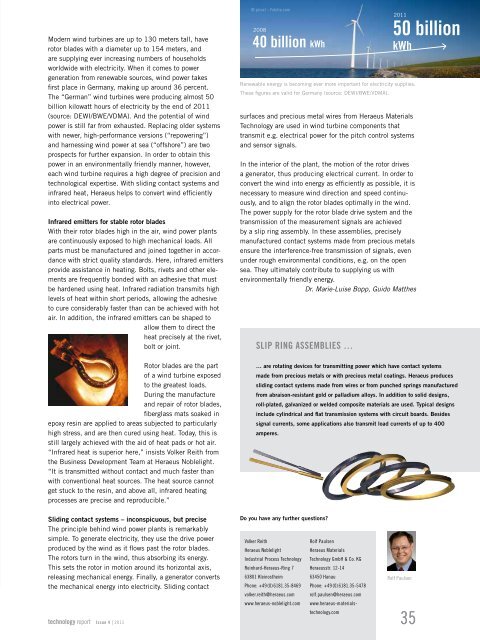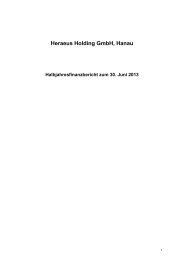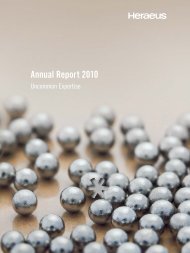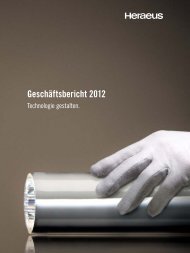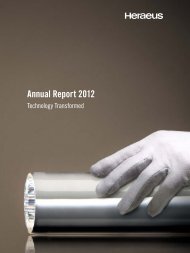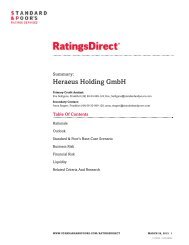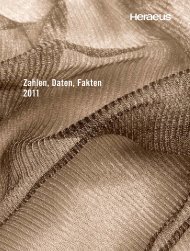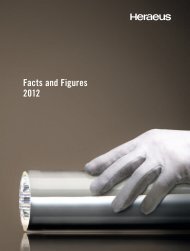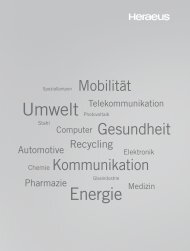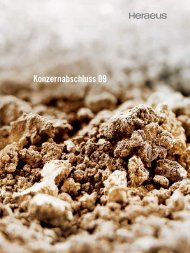technology report 04
technology report 04
technology report 04
Create successful ePaper yourself
Turn your PDF publications into a flip-book with our unique Google optimized e-Paper software.
Modern wind turbines are up to 130 meters tall, have<br />
rotor blades with a diameter up to 154 meters, and<br />
are supplying ever increasing numbers of households<br />
worldwide with electricity. When it comes to power<br />
generation from renewable sources, wind power takes<br />
first place in Germany, making up around 36 percent.<br />
The “German” wind turbines were producing almost 50<br />
billion kilowatt hours of electricity by the end of 2011<br />
(source: DEWI/BWE/VDMA). And the potential of wind<br />
power is still far from exhausted. Replacing older systems<br />
with newer, high-performance versions (“repowering”)<br />
and harnessing wind power at sea (“offshore”) are two<br />
prospects for further expansion. In order to obtain this<br />
power in an environmentally friendly manner, however,<br />
each wind turbine requires a high degree of precision and<br />
technological expertise. With sliding contact systems and<br />
infrared heat, Heraeus helps to convert wind efficiently<br />
into electrical power.<br />
Infrared emitters for stable rotor blades<br />
With their rotor blades high in the air, wind power plants<br />
are continuously exposed to high mechanical loads. All<br />
parts must be manufactured and joined together in accordance<br />
with strict quality standards. Here, infrared emitters<br />
provide assistance in heating. Bolts, rivets and other elements<br />
are frequently bonded with an adhesive that must<br />
be hardened using heat. Infrared radiation transmits high<br />
levels of heat within short periods, allowing the adhesive<br />
to cure considerably faster than can be achieved with hot<br />
air. In addition, the infrared emitters can be shaped to<br />
allow them to direct the<br />
heat precisely at the rivet,<br />
bolt or joint.<br />
© picsxl – Fotolia.com<br />
2008<br />
50 billion<br />
40 billion kWh<br />
2011<br />
kWh<br />
Renewable energy is becoming ever more important for electricity supplies.<br />
These figures are valid for Germany (source: DEWI/BWE/VDMA).<br />
surfaces and precious metal wires from Heraeus Materials<br />
Technology are used in wind turbine components that<br />
transmit e.g. electrical power for the pitch control systems<br />
and sensor signals.<br />
In the interior of the plant, the motion of the rotor drives<br />
a generator, thus producing electrical current. In order to<br />
convert the wind into energy as efficiently as possible, it is<br />
necessary to measure wind direction and speed continuously,<br />
and to align the rotor blades optimally in the wind.<br />
The power supply for the rotor blade drive system and the<br />
transmission of the measurement signals are achieved<br />
by a slip ring assembly. In these assemblies, precisely<br />
manufactured contact systems made from precious metals<br />
ensure the interference-free transmission of signals, even<br />
under rough environmental conditions, e.g. on the open<br />
sea. They ultimately contribute to supplying us with<br />
environmentally friendly energy.<br />
Dr. Marie-Luise Bopp, Guido Matthes<br />
Slip ring assemblies …<br />
Rotor blades are the part<br />
of a wind turbine exposed<br />
to the greatest loads.<br />
During the manufacture<br />
and repair of rotor blades,<br />
fiberglass mats soaked in<br />
epoxy resin are applied to areas subjected to particularly<br />
high stress, and are then cured using heat. Today, this is<br />
still largely achieved with the aid of heat pads or hot air.<br />
“Infrared heat is superior here,” insists Volker Reith from<br />
the Business Development Team at Heraeus Noblelight.<br />
“It is transmitted without contact and much faster than<br />
with conventional heat sources. The heat source cannot<br />
get stuck to the resin, and above all, infrared heating<br />
processes are precise and reproducible.”<br />
… are rotating devices for transmitting power which have contact systems<br />
made from precious metals or with precious metal coatings. Heraeus produces<br />
sliding contact systems made from wires or from punched springs manufactured<br />
from abraison-resistant gold or palladium alloys. In addition to solid designs,<br />
roll-plated, galvanized or welded composite materials are used. Typical designs<br />
include cylindrical and flat transmission systems with circuit boards. Besides<br />
signal currents, some applications also transmit load currents of up to 400<br />
amperes.<br />
Sliding contact systems – inconspicuous, but precise<br />
The principle behind wind power plants is remarkably<br />
simple. To generate electricity, they use the drive power<br />
produced by the wind as it flows past the rotor blades.<br />
The rotors turn in the wind, thus absorbing its energy.<br />
This sets the rotor in motion around its horizontal axis,<br />
releasing mechanical energy. Finally, a generator converts<br />
the mechanical energy into electricity. Sliding contact<br />
Do you have any further questions?<br />
Volker Reith<br />
Heraeus Noblelight<br />
Industrial Process Technology<br />
Reinhard-Heraeus-Ring 7<br />
63801 Kleinostheim<br />
Phone: +49(0)6181.35-8469<br />
volker.reith@heraeus.com<br />
www.heraeus-noblelight.com<br />
Rolf Paulsen<br />
Heraeus Materials<br />
Technology GmbH & Co. KG<br />
Heraeusstr. 12-14<br />
63450 Hanau<br />
Phone: +49(0)6181.35-5478<br />
rolf.paulsen@heraeus.com<br />
www.heraeus-materials-<br />
Rolf Paulsen<br />
<strong>technology</strong>.com<br />
<strong>technology</strong> <strong>report</strong> Issue 4 | 2013 35


